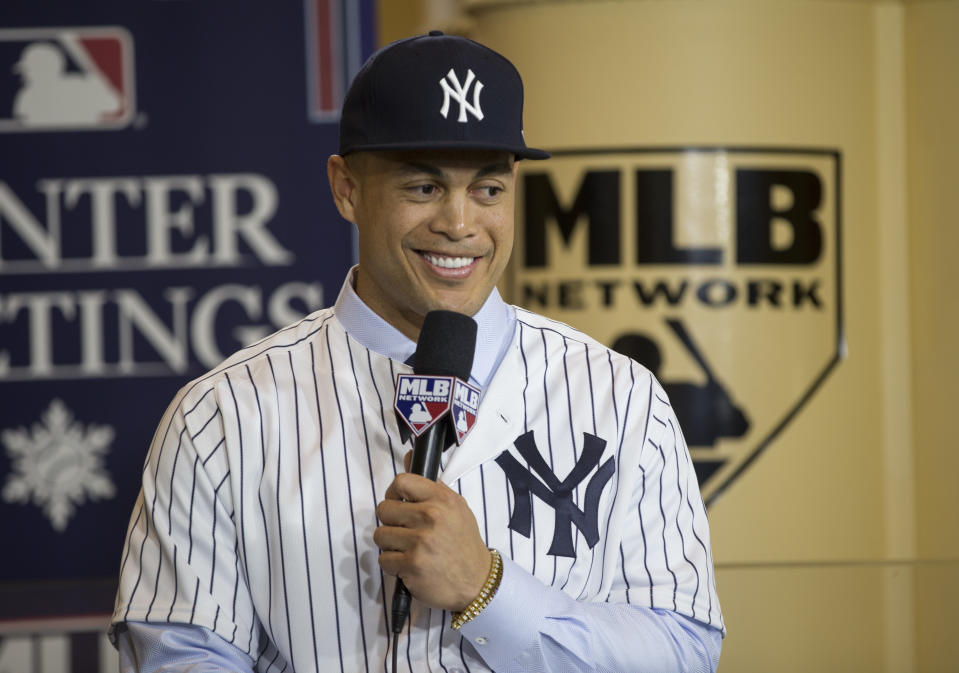Baseball payrolls could drop for first time in nearly a decade as free-agent freeze deepens

Projected opening day payrolls for Major League Baseball teams have cratered this offseason, with teams’ estimated outlay on players lower than last season despite record revenues of more than $10 billion, according to an analysis by Yahoo Sports. How grim is it? The New York Yankees aren’t even among the top-five-spending teams anymore.
As players coalesce in their anger over a free-agent market that has left dozens jobless on the eve of spring training, the lack of spending can be quantified in a bigger-picture way than simply free agency. Teams have committed nearly $285 million less to player salaries in 2018 than their opening day payrolls in 2017, according to a comparison of Baseball Prospectus’ 2018 payroll estimates to last year’s figures provided by the Associated Press.
[Stream Super Bowl LII live on the Yahoo Sports mobile app]
It would mark the first drop in payroll at the beginning of a season since 2009, when salaries dipped 1.3 percent. Since then, they’ve risen on average 5.5 percent a year, exceeding the $4 billion mark on opening day last year. Currently, teams have committed around $3.78 billion – a 7 percent decline from last season. And while the eventual signings of top free agents Yu Darvish, J.D. Martinez, Eric Hosmer and Jake Arrieta will help bring that number closer to the $4 billion mark, the prospect of wage stagnation is another trend that troubles players as they consider how to voice their displeasure.
They did so in amusingly passive-aggressive fashion Thursday, responding to a reasonable pace-of-play proposal by commissioner Rob Manfred with a text message from union chief Tony Clark to reporters that said, essentially, he’d be happy to talk about pitch clocks and mound visits when major league teams start giving players jobs.
Eleven days before the first pitchers and catchers report to spring training, the panoply of free agents is unlike anything baseball ever has seen, even during the collusion era, and players are struggling to figure out a market that never materialized. The confluence of high-spending teams eager to get under the competitive-balance-tax threshold and more than 10 teams not eager to win created this odd reality, where average is a curse word as teams vie for the extremes.
Projected payrolls tell an enormous part of the story. Currently, 16 teams are spending less than they did last spring. How much less they’re spending is the most interesting part. The Detroit Tigers have cut their payroll by $77.2 million, according to Baseball Prospectus. Next are the Philadelphia Phillies ($48.2 million), Texas Rangers ($43.3 million), Baltimore Orioles ($43.1 million) and Los Angeles Dodgers ($40.1 million). Behind them, each with more than $30 million cut, are the Kansas City Royals, New York Yankees, Miami Marlins and Chicago White Sox.
That the Yankees and Dodgers – the two highest-earning teams in the game – have whacked a combined $73.6 million from their 2017 opening day payrolls exemplifies the movement in the game. Currently, the Yankees’ $161.8 million payroll sits behind the Boston Red Sox ($204.4 million), San Francisco Giants ($194.5 million), Dodgers ($185.4 million), Washington Nationals ($178.3 million) and Los Angeles Angels ($166.3 million).
With about $14 million in player benefits factored into the CBT calculations, the Yankees have somewhere in the neighborhood of $20 million to spend before exceeding the $197 million threshold. Their austerity has left an unlikely team in the spot for highest year-over-year payroll jump: the Milwaukee Brewers.
In addition to signing center fielder Lorenzo Cain to an $80 million deal – the biggest this offseason by a good margin – the Brewers traded for outfielder Christian Yelich and are projected to pay $30.2 million more for players this season than last, when they started the year with the lowest payroll in the major leagues.
The world champion Houston Astros have made the second-biggest leap this offseason at ($29.9 million), followed by the Arizona Diamondbacks ($27.6 million), Red Sox ($25.6 million) and Nationals ($13.8 million). Amid some teams’ maneuvering, the Atlanta Braves, Baltimore Orioles, Miami Marlins, Pittsburgh Pirates and Tampa Bay Rays haven’t spent a penny on major league free agents this offseason, furthering the impasse.
The five lowest-projected payrolls thus far are from the Rays ($79.8 million), San Diego Padres ($70.3 million), White Sox ($69.5 million), Phillies ($63.7 million) and Oakland A’s ($58.2 million). The last team to start opening day with a payroll as low as Oakland’s currently is: The 2014 Astros, at $44.5 million, which was an $18 million improvement from the previous season.
Those Astros’ success tanking only emboldened teams this offseason, and here stands baseball, with players talking openly about a work stoppage, with teams attempting to avoid free-agent foolishness of the past and with the convergence of the two inviting labor discord unseen in nearly a quarter century. Despite their differences with management, the players always have been placated with growth of their salaries remaining somewhat commensurate to that of the teams’ revenues.
With franchise values 2½ times what they were five years ago and sport-wide revenues consistently in the 11 figures and profits for teams at their highest levels ever, a decrease in overall salaries would be seen as a clear sign by players that a winter of discontent will turn into a spring of strife in which the already-growing chasm between the sides further widens.
More from Yahoo Sports:
• How do the Patriots maintain a dynasty?
• Russell Westbrook shoves fan after loss in Denver
• Meet the next hot NFL coach from Belichick tree
• Father of 3 victims attacks Nassar during sentencing

